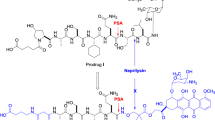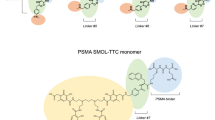Abstract
High toxicity caused by chemotherapeutic drugs and the acquisition of drug resistance by cancer cells are the major drawbacks in cancer therapy. A promising approach to overcome the posed barriers is conjugating tumor-homing peptides to drugs or nanocarriers. Such high-affinity peptides can specifically target surface markers overexpressed by cancer cells, ensuring a rapid and cancer-specific uptake of the drugs. Since prostate-specific membrane antigen (PSMA) is overexpressed by aggressive prostate cancer cells, targeting this surface protein with peptide conjugates can lead to the development of effective strategies against prostate cancer. In this study, we aimed to determine which PSMA-binding peptide among peptides 563, 562 and 9-mer, show the highest selectivity towards PSMA using 22Rv1 prostate cancer cells, a cell line with moderate PSMA levels. Tumor-homing peptides were synthesized by fluorenylmethoxycarbonyl-based solid-phase peptide synthesis (Fmoc-SPPS) strategy, and evaluated for their prostate cancer cell-specific targeting efficiencies by flow cytometry. Our results showed that the PSMA-binding capacity of peptide 563 was superior to those of 562, 9-mer, and 5-mer; therefore, can be utilized as a potent-targeting agent not only in the treatment of high PSMA positive but also moderate PSMA positive prostate cancer tumors.



Similar content being viewed by others
References
Barrio M, Fendler WP, Czernin J, Herrmann K (2016) Prostate-specific membrane antigen (PSMA) ligands for diagnosis and therapy of prostate cancer. Expert Rev Mol Diagn 16(11):1177–1188
Bernard D, Pourtier-Manzanedo A, Gil J, Beach DH (2003) Myc confers androgen-independent prostate cancer cell growth. J Clin Investig 112(11):1724–1731
Burger MJ, Tebay MA, Keith PA, Samaratunga HM, Clements J, Lavin MF, Gardiner RA (2002) Expression analysis of δ-catenin and prostate-specific membrane antigen: their potential as diagnostic markers for prostate cancer. Int J Cancer 100(2):228–237
Carter R, Feldman A, Coyle J (1996) Prostate-specific membrane antigen is a hydrolase with substrate and pharmacologic characteristics of a neuropeptidase. Proc Natl Acad Sci USA 93(2):749–753
Castranes MA, Copeland BT, Chowdhury WH, Liu MM, Rodriguez R, Pomper MG, Lupold SE, Foss CA (2016) Characterization of a novel metastatic prostate cancer cell line of LNCaP origin. Prostate 76(2):215–225
Cultrara CN, Shah S, Antuono G, Heller CJ, Ramos JA, Samuni U, Zilberberg J, Sabatino D (2019) Size Matters: arginine-derived peptides targeting the PSMA receptor can efficiently complex but not transfect siRNA. Nucleic Acids 18:863–870
Dellis A, Zagouri F, Liontos M, Mitropoulos D, Bamias A, Papatsoris AG (2018) Management of advanced prostate cancer: a systematic review of existing guidelines and recommendations. Cancer Treat Rev 73:54–61
Denmeade SR, Isaacs JT (2002) A history of prostate cancer treatment. Nat Rev Cancer 2(5):389–396
Evans MJ, Smith-Jones PM, Wongvipat J, Navarro V, Kim S, Bander NH, Larson SM, Sawyers CL (2011) Non-invasive measurement of androgen receptor signaling with a positron-emitting radiopharmaceutical that targets prostate-specific membrane antigen. Proc Natl Acad Sci 108(23):9578–9582
Feldman BJ, Feldman D (2001) The development of androgen-independent prostate cancer. Nat Rev Cancer 1(1):34–45
Ferreira HT, Oliveira Freitas LB, Fernandes RS, Santos VM, Resende JM, Cardoso VN, Barros ALB, Sousa EMB (2019) Boron nitride nanotube-CREKA peptide as an effective target system to metastatic breast cancer. J Pharm Investig 50:469–480
Gao Y, Li Y, Li Y, Yuan L, Zhou Y, Li J, Zhao L, Zhang C, Li X, Liu Y (2015) PSMA-mediated endosome escape-accelerating polymeric micelles for targeted therapy of prostate cancer and the real time tracing of their intracellular trafficking. Nanoscale 7(2):597–612
Gorges TM, Riethdorf S, Ahsen O, Nastały P, Röck K, Boede M, Peine S, Kuske A, Schmid E, Kneip C, König F, Rudolph M, Pantel K (2016) Heterogeneous PSMA expression on circulating tumor cells—a potential basis for stratification and monitoring of PSMA-directed therapies in prostate cancer. Oncotarget 7(23):34930–34941
Haberkorn U, Eder M, Kopka K, Babich JW, Eisenhut M (2016) New strategies in prostate cancer: Prostate-specific membrane antigen (PSMA) ligands for diagnosis and therapy. Clin Cancer Res 22(1):9–15
Harris WP, Mostaghel EA, Nelson PS, Montgomery B (2009) Androgen deprivation therapy: progress in understanding mechanisms of resistance and optimizing androgen depletion. Nat Clin Pract Urol 6(2):76–85
Henry MD, Wen S, Silva MD, Chandra S, Milton M, Worland PJ (2004) A prostate-specific membrane antigen-targeted monoclonal antibody-chemotherapeutic conjugate designed for the treatment of prostate cancer. Can Res 64(21):7995–8001
Hynds RE, Vladimirou E, Janes SM (2018) The secret lives of cancer cell lines. Disease Models Mech 11(11):dmm037366
Kaiser E, Colescott RL, Bossinger CD, Cook PI (1970) Color test for detection of free terminal amino groups in the solid-phase synthesis of peptides. Analytical Biochem 34(2):595–598
Kiess AP, Banerjee SR, Mease RC, Rowe SP, Rao A, Foss CA, Chen Y, Yang X, Cho SY, Nimmagadda S, Pomper MG (2015) Prostate-specific membrane antigen as a target for cancer imaging and therapy. Q J Nucl Med Mol Imaging 59(3):241–268
Litwin MS, Tan HJ (2017) The diagnosis and treatment of prostate cancer: a review. JAMA - J Am Med Assoc 317(24):2532–2542
Lupold S, Rodriguez R (2004) Disulfide-constrained peptides that bind to the extracellular portion of the prostate-specific membrane antigen. Mol Cancer Ther 3(5):597–603
O’Keefe DS, Bacich DJ, Huang SS, Heston WDW (2018) A perspective on the evolving story of PSMA biology, PSMA-based imaging, and endoradiotherapeutic strategies. J Nucl Med 59(7):1007–1013
Pagoto A, Tripepi M, Stefania R, Lanzardo S, Longo DL, Garello F, Porpiglia F, Manfredi M, Aime S, Terreno E (2018) An efficient MRI agent targeting extracellular markers in prostate adenocarcinoma. Magn Reson Med 81:1935–1946
Pilat MJP, Kamradt JM, Pienta KJ (1998) Hormone resistance in prostate cancer. Cancer Metastasis Rev 17(4):373–381
Rajasekaran AK, Anilkumar G, Christiansen J (2005) Is prostate-specific membrane antigen a multifunctional protein? Am J Physiol Cell Physiol 288(5):C975-981
Savarese DM, Halabi S, Hars V, Akerley WL, Taplin M, Godley PA, Hussain A, Small EJ, Vogelzang NJ (2001) Hydrocortisone in men with hormone-refractory prostate cancer: a final report of CALGB 9780. J Clin Oncol 19(9):2509–2516
Shen D, Xie F, Edwards WB (2013) Evaluation of phage display discovered peptides as ligands for prostate-specific membrane antigen (PSMA). PLoS ONE 8(7):1–8
Siegel RL, Miller KD, Jemal A (2019) Cancer statistics. A Cancer J Clin 69(1):7–34
Silver DA, Pellicer I, Fair WR, Heston WDW, Cordon-Cardo C (1997) Prostate-specific membrane antigen expression in normal and malignant human tissues. Clin Cancer Res 3(1):81–85
Simberg D, Duza T, Park JH, Essler M, Pilch J, Zhang L, Derfus AM, Yang M, Hoffman RM, Bhatia S, Sailor MJ, Ruoslahti E (2006) Biomimetic amplification of nanoparticle homing to tumors. Proc Natl Acad Sci USA 104(3):932–936
Telci D, Collighan RJ, Basaga H, Griffin M (2009) Increased TG2 expression can result in induction of transforming growth factor 1, causing increased synthesis and deposition of matrix proteins, which can be regulated by nitric oxide. J Biol Chem 284(43):29547–29558
Wenger SL, Senft JR, Sargent LM, Bamezai R, Bairwa N, Grant SG (2004) Comparison of established cell lines at different passages by karyotype and comparative genomic hybridization. Biosci Rep 24(6):631–639
Wu X, Yu G, Lindner D, Brady-Kalnay SM, Zhang Q, Lu ZR (2014) Peptide targeted high-resolution molecular imaging of prostate cancer with MRI. Am J Nuclear Med Mole Imaging 4(6):525–536
Wüstemann T, Haberkorn U, Babich J, Mier W (2018) Targeting prostate cancer: prostate-specific membrane antigen based diagnosis and therapy. Med Res Rev 39(1):40–69
Xu L, Wang Z, Li XF, He X, Guan LL, Tuo JL, Wang Y, Luo Y, Zhong HL, Qiu SP, Cao KY (2013) Screening and identification of significant genes related to tumor metastasis and PSMA in prostate cancer using microarray analysis. Oncol Rep 30(4):1920–1928
Yamamichi F, Matsuoka T, Shigemura K, Kawabata M, Shirakawa T, Fujisawa M (2012) Potential establishment of lung metastatic xenograft model of androgen receptor-positive and androgen-independent prostate cancer (C4–2B). Urology 80(4):951.e1-951.e7
Zhu Y, Sun Y, Chen Y, Liu W, Jiang J, Guan W, Zhang Z, Duan Y (2015) In vivo molecular imaging of prostate cancer by targeting PSMA with polypeptide-labeled superparamagnetic iron oxide nanoparticles. Int J Mol Sci 16(5):9573–9587
Acknowledgements
We would like to thank Ayla Burcin Asutay for her technical support in flow cytometry.
Funding
This study is funded by TÜBİTAK under Grant number 315S049.
Author information
Authors and Affiliations
Corresponding author
Ethics declarations
Conflict of interest
The authors declare that they have no conflict of interest.
Ethics statement
No approval of human/animal use protocols is required.
Informed consent
No informed consent is required for this study.
Additional information
Handling editor: E. Agostinelli.
Publisher's Note
Springer Nature remains neutral with regard to jurisdictional claims in published maps and institutional affiliations.
Rights and permissions
About this article
Cite this article
Nezir, A.E., Khalily, M.P., Gulyuz, S. et al. Synthesis and evaluation of tumor-homing peptides for targeting prostate cancer. Amino Acids 53, 645–652 (2021). https://doi.org/10.1007/s00726-021-02971-3
Received:
Accepted:
Published:
Issue Date:
DOI: https://doi.org/10.1007/s00726-021-02971-3




